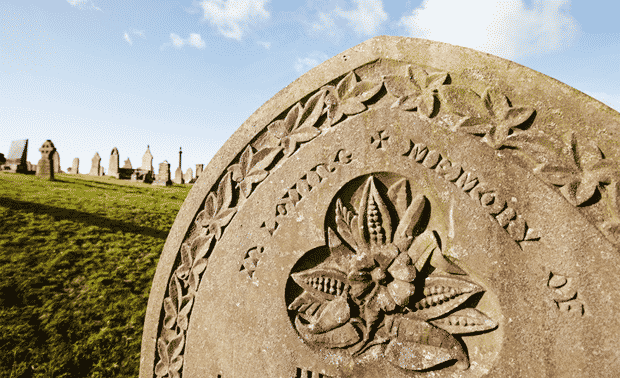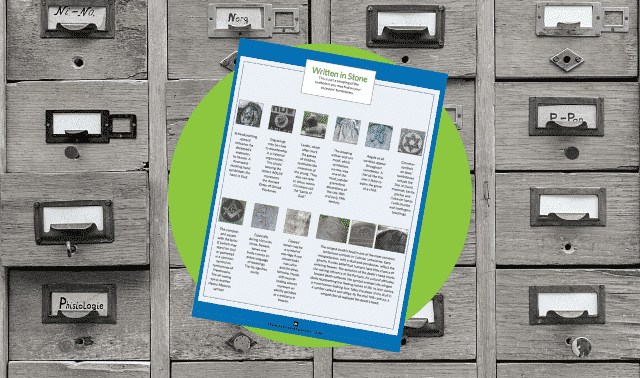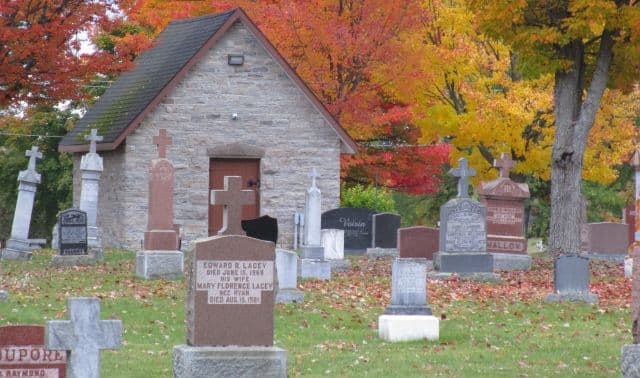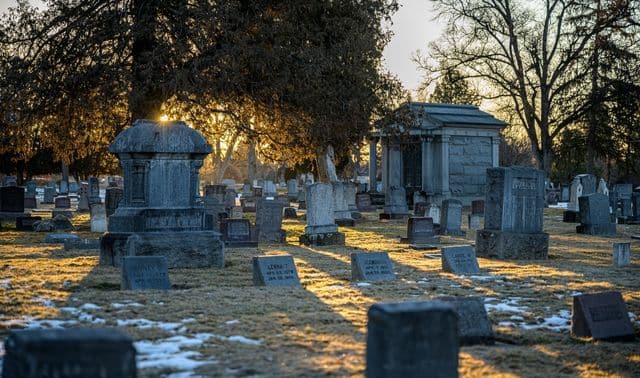Sign up for the Family Tree Newsletter! Plus, you’ll receive our 10 Essential Genealogy Research Forms PDF as a special thank you.
Get Your Free Genealogy Forms
"*" indicates required fields

A walk through a cemetery when researching ancestors can be a haunting, yet beautiful and reflective experience. Aside from names, birthdates and death dates, gravestones are often decorated with symbols and icons.
These majestic, weather-worn stone carvings were popularized by those cipher-loving Victorians (from 1839 to 1920) and are more than pure decoration. They mean something; a virtue the person exemplified, a value they held dear, or a nod to how they earned their living.
In the table below, learn the meanings behind some common (and several uncommon) gravestone symbols. A revelation about your ancestor’s life may just be right in front of you, hidden in plain sight.
ADVERTISEMENT
A word of caution before we get started, though: tombstone scholars still debate the meanings of certain symbols, so you could find varying interpretations. Don’t forget to grab your free download to common tombstone symbols before you head out on your next research trip!
Gravestone Symbols and Their Meanings
| Symbol | Meaning |
| Arches and gates | passage into the next life |
| Acorn | prosperity; power; triumph; strength; independence |
| Anchor | hope; Navy |
| Angels | God’s messengers and guardians; dropping flowers may signify grief, mourning; pointing to heaven may signify rejoicing |
| Anvil and/or hammer | blacksmith |
| Basket | fertility; maternal bond |
| Bat wings | death; misfortune |
| Beehive | possible membership with the Independent Order of Odd Fellows, or the Church of Jesus Christ of Latter-day Saints |
| Benches | mourning; contemplation |
| Bird | flight of the soul |
| Book | often the Bible; book of life |
| Bone | death |
| Candle | life |
| Church | ministry; possible pastor or minster |
| Clock | march of time, usually stopped at hour of death |
| Clover (three- or four-leafed) | Christian trinity; possible Irish ancestry or affiliation with 4H Club |
| Column and/or pillar (Broken) | life cut short; sudden death |
| Column and/or pillar (Unbroken) | a complete and full life |
| Corn | farming (also frequently symbolized by wheat) |
| Doves | peace; the Holy Spirit |
| Elk | possible membership with the Benevolent and Protective Order of Elks |
| Evergreen | faithfulness; remembrance |
| Feathered headdress | possible membership with the Improved Order of Red Men or Degree of Pocahontas |
| Fern | sincerity; humility; solitude |
| Forefinger pointing down | God reaching down for the soul |
| Forefinger pointing up | soul’s passage to Heaven |
| Fruit | eternal plenty |
| Half-carved tombstone | transition from life to death |
| Handshake | welcoming of a soul into Heaven; bond between spouses (if hands are feminine and masculine) |
| Harp | worship; music to God |
| Heart | a blissful soul (Colonial era); romantic love (Victorian era to today) |
| Horses | courage or generosity; possible membership with the International Brotherhood of Teamsters (especially if two-headed) |
| Hourglass or clock | the passage of time |
| Key | knowledge; entrance to heaven |
| Lambs | purity; gentleness; innocence; popular on children’s graves |
| Lamp | knowledge; spiritual immortality |
| Lily | innocence and purity; resurrection; marriage and fidelity (Calla); innocence and humility (Lily of the Valley) |
| Mariner | anchor; sextant |
| Mortar and pestle | medical profession (pharmacist or doctor) |
| Oak leaf | strength; stability; endurance |
| Olive tree | peace; reconciliation between God and man |
| Palm | life conquering death; resurrection |
| Phoenix | resurrection |
| Pineapple | prosperity; hospitality; perfection |
| Rose | love; beauty; virtue; motherhood; strong bond (intertwined); youthful death (rosebud) |
| Scales | justice; law |
| Shield | protection, faith, defense of the spirit |
| Shoes | (empty, one overturned) loss of a child |
| Skull | death; mortal remains |
| Soul effigy | immortality of the soul; passage to the afterlife (especially if winged) |
| Sphinx | courage; honor; power |
| Thistle | sorrow and remembrance; potential Scottish ancestry |
| Tree-shaped or tree stump | life cut short; sudden death; possible membership with the Modern Woodmen of America or Woodmen of the World |
| Urn | death of the flesh |
| Wheat | farming; harvest; prosperity; full life |
| Winged death’s head | mortal remains of the deceased |
| Willow | mourning and earthly sorrow |
Headstone Initials and Acronyms
| Initials | Meaning/Affiliation |
| AAONMS | Ancient Arabic Order of the Nobles of the Mystic Shrine (Masonic) |
| AASR | Ancient and Accepted Scottish Rite (Masonic) |
| BPOE | Benevolent and Protective Order of Elks |
| FOE | Fraternal Order of Eagles |
| IHC/HIS | Christian; the first three letters of Jesus’ name in Greek |
| IOOF | Independent Order of Odd Fellows |
| K of C | Knights of Columbus (Catholic) |
Changing Meanings
If you have pictures of tombstones from different parts of the country, you’ll notice regional symbols that evolved as attitudes toward death changed. For instance, the winged death head (a skull with wings), most commonly seen on the graves of New England colonists, is one of the earliest cemetery art forms in America. The Puritans viewed death in its stark reality: It was part of their daily lives, and they believed their salvation was never certain. They had little regard for physical remains, and hastily buried loved ones with minimal ceremony. Although the Puritans grieved privately, they deemed public expressions of sadness inappropriate.
Harriette Merrifield Forbes, author of Gravestones of Early New England, and the Men Who Made Them, 1653-1800, has grouped Colonial and early American symbols from New England into five categories, according to their significance:
ADVERTISEMENT
• recognition of the flight of time
• the certainty of death and warnings to the living
• the occupation of the deceased or his station in life
• the Christian life
• the resurrection of the body and the activities of the redeemed soul
Beginning in the early 1800s, Americans replaced the winged death head with symbols of mourning, hope and resurrection, as represented by the winged cherub, soul effigy, willows and urns. This transition no doubt stemmed from the Great Awakening revivals of the 1730s and 1740s. The old Calvinistic beliefs of predestination and damnation died, and notions of salvation through good deeds and divine grace took their place. Also during this period, people viewed the deceased as resting in a state of eternal sleep, so they adorned their loved ones’ graves with carved drapery, pillows, chairs, beds, flowers and other objects that would comfort them.
Headstone Materials
By determining the headstone’s composition, you can tell if the marker at your ancestor’s grave is the original or a replacement. Before the 1650s, people used mostly fieldstones or rough-cut rocks to mark graves. A stone from this time might have the deceased’s initials and death year carved on it. From about the 1660s to 1850s, headstones consisted of sedimentary rock, such as red or brown sandstone or limestone, and dark slate. You’ll also see early 1800s gravestones made from a grayish-blue slate. Marble was the stone of choice between the 1830s and 1880s. Since the 1880s, we’ve stuck with granite headstones. That means a granite stone with a pre-1880 death date isn’t the original marker.
A Note on Grave Epitaphs
Epitaphs are short verses or poems written to honor a deceased person, and they are frequently seen on gravestones.
Epitaphs typically reflect living relatives’ feelings toward the deceased, as survivors would select verses from monument makers’ and funeral directors’ catalogs. Occasionally, people would specify what they wanted on their tombstones—such pre-selected epitaphs tend to reflect the decedents’ personalities.
Like funerary art, epitaphs carved on gravestones reveal changing outlooks on death. Colonial verses were meant to provide instruction, not comfort. Here’s a common warning to the living:
Stranger, stop and cast an eye,
As you are now, so once was I,
As I am now, so you shall be,
Prepare for death and follow me.
Generally, families have derived epitaphs from popular or favorite poems, other classic literary works such as Shakespeare, and holy scriptures or prayers. As Americans came to favor more-comforting verses, scripture passages and prayers for mercy became the most common types of epitaphs.
Share this slideshow with your genealogy group!
FamilyTreeMagazine.com is a participant in the Amazon Associates Program, an affiliate advertising program. It provides a means for this site to earn advertising fees, by advertising and linking to Amazon and affiliated website.
ADVERTISEMENT






